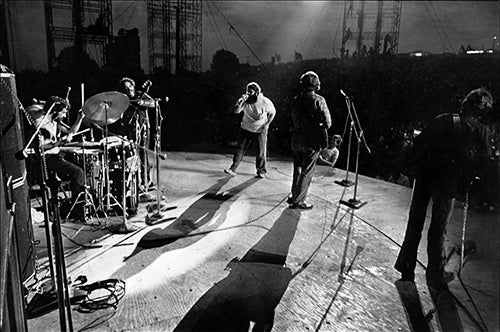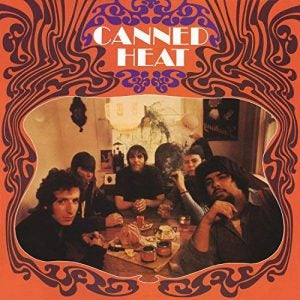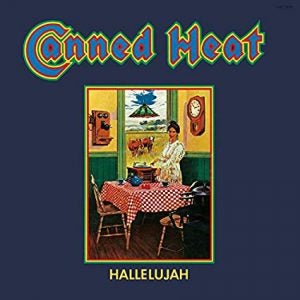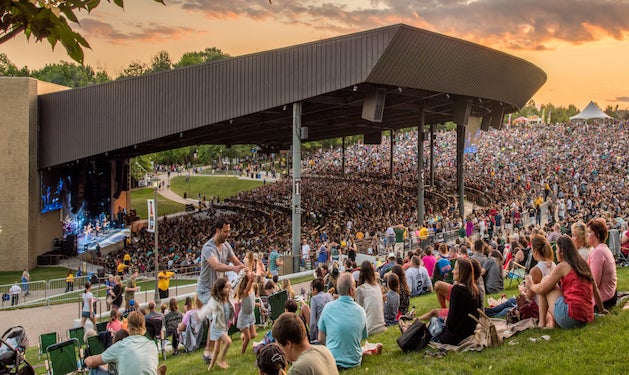Always the quintessential boogie band, Canned Heat performed at Woodstock at sunset on Saturday and got the audience on their feet with their hard-driving American roots/blues music.
Day Two, Performer 7: Canned Heat
Performed Saturday evening, August 16, 7:30–8:30 pm

Canned Heat perform on the Woodstock stage on Saturday evening. Left to right: Adolfo "Fito" de la Parra, Larry "The Mole" Taylor, Bob "The Bear" Hite, Alan "Blind Owl" Wilson, and Harvey "The Snake" Mandel. Photo © Elliott Landy.
Canned Heat Band Members
- Alan "Blind Owl" Wilson: guitar, harmonica, vocals
- Bob "The Bear" Hite: vocals, harmonica
- Harvey "The Snake" Mandel: guitar
- Larry "The Mole" Taylor: bass
- Adolfo "Fito" de la Parra: drums
Canned Heat Woodstock Setlist
- I'm Her Man
- Going Up the Country
- A Change is Gonna Come/Leaving This Town
- Rollin’ Blues
- Woodstock Boogie
- On the Road Again
Canned Heat was formed in Los Angeles in 1965 by Alan Wilson and Bob Hite, dedicated blues aficionados and record collectors whose knowledge of the history of the blues was at least equal to any distinguished blues scholar of their day. The band’s name, a euphemism for Sterno, was taken from a 1928 blues standard by Tommy Johnson about an alcoholic who had turned to drinking the cooking fuel during the prohibition era. Wilson, on vocals and harmonica, and Hite, on lead vocals, were initially joined by Mike Perlowin on guitar, Stu Brotman on bass, and Keith Sawyer on drums. This lineup collapsed shortly after its formation, with Perlowin and Sawyer being replaced by Kenny Edwards and Ron Holmes respectively, the latter agreeing to play on a temporary basis until a permanent drummer could be found.
Canned Heat’s lineup was solidified in early 1966 when they were joined by Henry Vestine, who was cultivating a deserved reputation as one of the best blues guitarists in Los Angeles. Vestine was fresh off a brief tenure with Frank Zappa’s Mothers Of Invention, at the end of which he was fired because he had no feel for Zappa’s more complex material (and because he enjoyed his drugs a bit too much for Zappa’s liking). Completing this lineup was Frank Cook, an accomplished drummer whose resume included work with jazz legends Chet Baker and Charlie Haden. After Kenny Edwards dropped out in mid-1966, the five-piece Canned Heat lineup recorded its first album, which would remain unreleased until 1970 when it was issued as Vintage Heat. The album was chock full of the Heat’s hard-hitting blues covers, and set the basic pattern for all future Canned Heat releases.
Stu Brotman left Canned Heat following the recording sessions for Vintage Heat; he was initially replaced on bass by Mark Andes, but he too would depart shortly after joining to co-found the legendary band Spirit. March 1967 saw Canned Heat find a permanent replacement for their bass position in the form of Larry Taylor, a head-banging session bassist whose pedigree included work on hits by The Monkees, as well as stints backing rock legends Chuck Berry and Jerry Lee Lewis. This lineup recorded their first released album, Canned Heat, in the summer of 1967. The album saw some chart action in the United States, and the band was given another boost that year when they played the Monterey International Pop festival. One of the songs from their Monterey Pop performance was included in D.A. Pennebaker’s classic film documentary of that first major rock festival.

After the band was busted for drug possession while on tour in Denver, Colorado, Frank Cook dropped out of the band. He was replaced by Mexican drummer Adolfo de la Parra, whose arrival moved Canned Heat into what became known as their “classic era.” During this period, wherein the band was going from strength to strength, the band members adopted the nicknames they would become very well-known for. Bob Hite’s husky physique earned him the nickname “The Bear,” while “The Blind Owl” was a fitting reference to Alan Wilson’s nearsightedness. Larry Taylor became “The Mole,” Henry Vestine was “Sunflower” and de la Parra was simply known as “Fito.”
This lineup recorded their second album, Boogie With Canned Heat, in late 1967. This included the band’s first single, a cover of Floyd Jones’ “On The Road Again,” cleverly arranged by Wilson to open and close with the drone of an Indian instrument, the tambura. Instantly, Canned Heat became major players on the American music scene, and their success was furthered by the release of their third album, Living The Blues, in November of 1968. This double album included solo spots for each of the band members, a 41-minute take on “Fried Hockey Boogie” from their second album, and another huge hit single with “Going Up The Country,” their reworking of an obscure 1928 Henry Thomas blues side. Sung by Alan Wilson and featuring a distinctive flute part played by Los Angeles session-pro Jim Horn, the song came to epitomize the so-called “hippie generation” and is used to reference that spirit in TV commercials to this day.
Canned Heat continued to roll through the first half of 1969, recording a fourth studio album, Hallelujah. Unfortunately, a relentless touring schedule and inner turmoil (exacerbated by the group’s legendary appetite for drugs) took its toll in July 1969 when Henry Vestine was ousted after a dispute with Larry Taylor. Vestine’s replacement was L.A. blues guitar wizard Harvey Mandel, who was given the nickname “The Snake” for, among other things, his slithering soloing style. Two weeks after Mandel joined Canned Heat, the group found itself in White Lake, New York for a set at Woodstock. Despite a mere two prior performances with Mandel, the band was poised to get the huge crowd boogieing as the daylight melted away, ushering in a hot night of rock and roll.

hit the streets in early 1969, shortly before their
rousing performance at Woodstock
Following an enthusiastic intro from Chip Monck, Bob “The Bear” Hite informed the audience that “we’re just gonna play a little blues!” before launching into “I’m Her Man,” a Bob Hite song recently released on their album Hallelujah. After telling the audience about the group’s recent personnel woes, Bob Hite introduced guitarist/vocalist Alan “Blind Owl” Wilson to perform the group’s recent hit single, “Going Up The Country,” which became an anthem of sorts for Woodstock when the studio version was prominently featured in the Michael Wadleigh documentary released the following year.
This was followed by a chugging blues, featuring The Bear pulling lyrics from a number of classic blues tunes including Robert Johnson’s “Crossroads” and “When You Got A Good Friend” as well as touching on a bit of Sam Cooke’s “A Change Is Gonna Come.” During this song, while Michael Wadleigh moved his camera between the musicians as they rocked out, an audience member managed to make it onto the stage to hit up Bob Hite for a cigarette. It was then back to the Blind Owl, for a locomotive little ditty based on John Lee Hooker’s “Rollin’ Blues.”
At this point, it was time to bring the boogie to the people. The band struck up the riff to their “Fried Hockey Boogie” from the 1968 Boogie With Canned Heat album (and also “Refried Boogie” from Living The Blues), Bob Hite improvising lyrics as it went along. This number stretched out to a mammoth 30 minutes, including a stunning slide guitar intro from Alan Wilson, a lengthy bass solo from Larry Taylor and an equally lengthy drum solo from Fito de la Parra as well as some blistering guitar solos from Harvey Mandel. Upon its release on the 1971 Woodstock Two album, this improvisation would be titled “Woodstock Boogie” by producer Eric Blackstead. The crowd was whipped into an absolute frenzy by this onslaught, earning one of the loudest and most sustained ovations of the entire festival.
An encore was demanded, and Canned Heat brought it with an all-out version of their hit “On The Road Again” (again from Boogie With Canned Heat), featuring some deep and intense guitar solos from both Alan Wilson and Harvey Mandel as well as some killer harp courtesy of Bob Hite. This brought the house down, and with the sun now down for the night, the amped-up crowd was fully fired up. Canned Heat would be a tough act to follow.
The “Woodstock lineup” of Canned Heat would last for most of the next year, recording the band’s fifth studio album, Future Blues. This included what would turn out to be their final hit single, a cover of Wilbert Harrison’s “Let’s Work Together” that was very much in keeping with the “we are one” spirit of Woodstock. In the spring of 1970, Harvel Mandel and Larry Taylor left Canned Heat to join the latest incarnation of British blues ace John Mayall’s Bluesbreakers. This set the stage the return of Henry Vestine and the recruitment of a friend of Fito de la Parra’s, Antonio de la Barreda, on bass. This lineup recorded the album Hooker ’n Heat with blues legend John Lee Hooker.
Unfortunately, this marked the start of a sad slide for the kings of the boogie. Alan “Blind Owl” Wilson died in September 1970 under suspicious circumstances in the woods behind Bob Hite’s Topanga Canyon home, becoming the first of the Woodstock performers to “leave the stage” permanently. Stunned, the band stumbled through the 1970s with a variety of lineups but without ever truly recovering from Wilson’s death. Erratic, drug-fueled behavior made them unpredictable for concert promoters and by the end of the decade, they were reduced to playing small biker bars for whatever money they could get. On April 5, 1981, in between sets at the Palomino Club in Los Angeles, Bob Hite mistakenly ingested a massive amount of heroin, mistaking it for cocaine. This tragic accident led to his death at the age of 38.
Of the remaining original members, only drummer Fito de la Parra has remained with the group since he joined in 1967, although he also indulged in occasional side gigs with the likes of Big Joe Turner, T-Bone Walker, Albert Collins, and George “Harmonica” Smith. Bassist Larry Taylor has had a long and varied career, playing with John Mayall, Tom Waits, Albert King, and others, and founding a long-running music festival in Texas. Harvey Mandel, having stayed with Canned Heat only a year, eventually struck out on his own, working with various other artists. His guitar work can be heard on two songs on The Rolling Stones’ 1976 album Black and Blue, “Hot Stuff” and “Memory Motel.” Henry Vestine, who did not play at Woodstock but was part of the band’s “classic era” line up, died in 1997 in Paris at the close of a Canned Heat European tour. Mandel, Taylor, and de la Parra reunited in 2009 for a series of Woodstock 40th anniversary appearances, and this lineup lasted for a few years until Mandel again dropped out due to health issues. Taylor and de la Parra continue to tour with the rest of the current incarnation of Canned Heat.
—Wade Lawrence & Scott Parker
